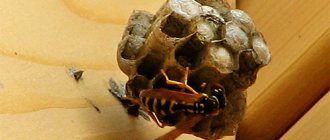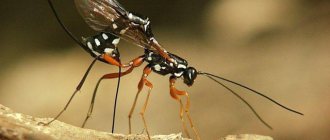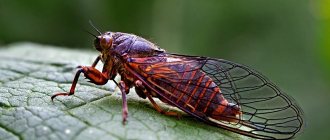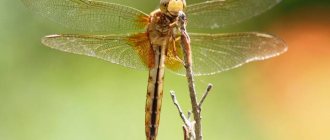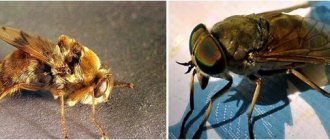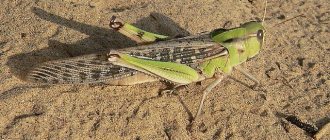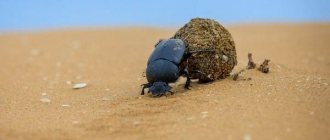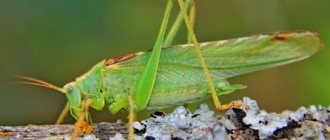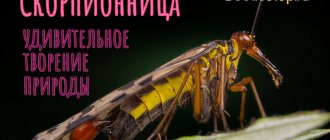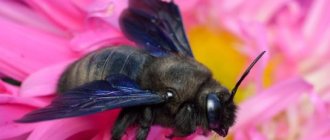The destruction of any parasite is effective only if their offspring are neutralized. The same is true with wasps. If you ignored this stage of the fight against the parasite, the colony will very quickly recover and again conquer your territory. If you find a nest with larvae, you need to start destroying them.
What do wasp larvae look like?
Aggressive pests go through a certain stage of transformation during their life. First, the female lays a larva, which develops very quickly and gradually transforms into a “pupa.”
Next, all organs are formed, the digestive system changes completely. After some time, an adult, viable individual flies out of the honeycomb. It’s interesting, but during the period of its growth the larva is not able to eat the food that wasps are accustomed to.
“Parents” obtain exclusively organic food for them: spiders, flies, cockroaches, and other insects. To make food suitable, the wasp paralyzes the prey and brings larvae to the honeycomb. The offspring slowly eats the victim.
The larva is practically motionless and can only rotate its head. The “pupa” of the paper wasp differs little from the offspring of other species of these pests. The difference may only be in the size of the larvae. In earthen parasites, the body has a rounded shape; individual segments can be clearly seen on it.
The wasp larva does not look at all like an adult; it does not yet have membranous wings or large paws. The new generation is not able to move at all, which is why they develop inside the honeycomb and do not leave it until the body is fully formed. Due to the reduced legs at the development stage, the larva can crawl a little, but only by wriggling strongly, resembling an ordinary caterpillar.
wasp larval development stages
The head of the larva is very small, almost invisible, but the jaws are well developed and are capable of chewing food.
The larvae are light in color: from whitish to yellow.
The complete transformation of the wasp's offspring occurs in the honeycomb. First, the wasps lay their larvae on the walls, practically blocking the entrance to the shelter with special glue so that the offspring do not fall out. As soon as the larvae begin active growth, their body increases sharply and they can no longer fall out of a kind of hole. Only the head of the future insect peeks out.
Description and features
The wasp is brightly colored. The pattern on her body is an alternation of black areas with yellow stripes on the body, as well as a pattern of the same color on the head and six legs.
Usually the bright color of insects in nature often indicates that this creature is poisonous. Wasps are often the name given to all stinging flying insects belonging to the suborder Stalk-bellied insects, with the exception of bees.
All wasps in the photo look the same, just like in real life, but they may differ in size. They have four transparent wings arranged in pairs. In addition, they have a very powerful mouthparts and faceted eyes, which provide the insect with excellent vision.
Coarse hairs can be observed on their paws, allowing such creatures to grip and hold on to a variety of surfaces.
This insect has two ways of fighting against the enemies that the wasp has in nature: mammals, birds, lizards and others.
First of all, the bright colors themselves provide powerful protection. It frightens the enemy, and hunters of various stripes, hungry for prey, lose their appetite when they look at the wasps. It’s just that their color causes unpleasant associations in many living creatures.
But even if one of the predators foolishly attempts to feast on such an insect, after the first misfire, their desires completely disappear. It's just that the sensations are not very pleasant. Therefore, subsequently, enemies stop making attempts to hunt wasps, having developed a warning reflex in themselves.
But in addition to passive methods of protection, these insects also have active methods. And their poisonous sting helps them in this - an autonomous organ, similar to a dagger blade in appearance and principle of action.
It freely penetrates under the skin of the animal, and also comes out without difficulty, having previously injected its portion of poison. This organ is located at the end of the abdomen, like a bee, because it is an insect very similar to a wasp , also capable of stinging.
But the bites of these two poisonous creatures have a number of differences, primarily for themselves. Unlike bees, who die after using their sharp weapon at least once and leaving it in the enemy’s body, wasps remain alive.
When a wasp stings, it does not leave a sting, unlike a bee.
Moreover, they feel great after a bite and are quite capable of making a new attack. In addition, wasps are endowed with the ability to use not only stings, but powerful jaws when attacking. But, like bees, these insects, sensing the smell of poison released by a fellow insect into the enemy’s body, will certainly enter into battle, collectively attacking the object that caused the alarm.
Externally, these insects are certainly similar, but it is not very difficult to distinguish them even by color. If the wasp is yellow and black, then the stripes on the bee’s body have a slightly different hue, with the addition of orange tones.
Pictured is a wasp and a bee
Types of wasps
Zoologists have described a huge number of varieties of wasps. They differ in the pattern located on the head, usually in the front part. In most cases, the drawing stands out for its clarity, but its shape can be very different. For example, the common wasp has a pattern in the shape of an anchor.
All types of wasps belong to one of two categories: social representatives of these insects and solitary ones. What this means will be discussed later. First, let’s describe some of the representatives of these types. And let's start with the first of them.
Paper wasps are a group that includes many subfamilies. Only in the central regions of Europe there are about 60 such species, and around the world there are about a thousand.
These insects are also simply called social wasps, since they live in colonies that have a cohesive and very interesting social structure.
And such wasps earned their first name – “paper” – because of the way they build their nests. This will also be discussed later.
Paper wasps get their name from their nest material, which resembles paper.
Hornets are the name of a whole genus of paper wasps. Moreover, its representatives are distinguished by significant sizes, reaching a length of 55 cm (but these are the largest). Such insects live in the Northern Hemisphere and are considered endangered today, and therefore it is clear that they are not common.
The hornet wasp has a significant width of the crown and a rounded abdomen compared to other relatives. The venom of such insects is incredibly effective, and therefore their bites are extremely painful. And the person affected by them, as a rule, receives medical assistance.
These attacks are all the more dangerous because such an insect is capable of making several injections of poison in a row. Deaths among people affected by such attacks are also common. Hornets have recently been classified as true wasps - a family that also includes the subfamilies Vespina and Polistina.
The hornet and the wasp are similar in appearance, but differ in size
Solitary wasps, as the name itself suggests, differ from their social relatives in their natural predisposition to a solitary existence. Such insects include the following subfamilies of the wasp kingdom, which are worthy of special mention.
1. Flower wasps are small creatures whose length usually does not exceed a centimeter. Their food consists of pollen and flower nectar. They build their nests from sand and clay, moistening them with saliva.
Their life cycle, including the larval stage, is about two years. In total, about a hundred varieties of such wasps are known. They usually hang around in places where there is a source of food for them, that is, flowers.
2. Sand wasps . There are many more species of such insects, compared to those just described. There are about 8800 of them in the world. Their body length can be quite small, about half a centimeter.
But there are larger specimens. Their sizes reach up to 2 cm. They are found mainly in the tropics. They feed on insects, first paralyzing them with their poison. Nests are built in the ground.
The body of most wasps is black and yellow.
There is a wide variety of sand wasps, including sand and burrowing ones.
But there are exceptions, because specimens of unusual colors live on earth. For example, black wasps . These insects can be large or medium in size.
Their venom is extremely toxic. They are found mostly in the tropics, but there are varieties that take root well in colder areas. The favorite prey of such creatures are spiders, which they hunt with great skill. And the meat of the victims is used to feed the larvae.
red wasps are also found in nature . They are also considered unconditionally dangerous for representatives of the human race.
Where do insects live
Species of social representatives build nests and form a hive. They set up a place of residence in an area where there is building material and food. Abandoned nests, rodent burrows, and anthills are often favorable places. As well as ordinary grass, dense tree crowns, thickets of bushes, stones, mounds of soil. They can settle on the territory of human possessions - garden, vegetable garden, outbuildings, roof, attic, balcony. The wasps spend the entire summer in the hive and leave the nest with the onset of cold weather. Only young fertilized females survive, finding shelter for wintering under the bark of trees and crevices.
Solitary representatives live in the wild, spending the night with their jaws and paws hooked on the grass. They climb into a flower. It is impossible to determine their exact location, since it is constantly changing.
Lifestyle and habitat
Wasps can be found almost everywhere, in almost every corner of the planet, with the exception of areas that are particularly unsuitable for life. They prefer to settle close to humans, because in the immediate vicinity of people and their homes there is always something to eat.
Now it's time to talk more about the social structure inherent in paper wasps. It is these representatives of the diversity of species already described that should be given special attention, because when they talk about wasps, they usually mean wild social wasps. Although this is not entirely correct.
The groups in which these insects gather to live together are close-knit families called colonies. They can have up to 20 thousand members. In such families there is a clearly established social structure and division into castes with a certain range of responsibilities.
The uterus is engaged in breeding offspring. Worker wasps look after the larvae, feed the rest of the family and guard the common home. The queen builds a nest out of a paper-like material.
It is produced naturally by wasps themselves, by grinding wood and mixing the material with their own saliva. Powerful jaws help these creatures build nests.
With these, the queen is capable of finely grinding hard wood. Worker wasps and drones are on average about 18 mm in size, but the queen of these insects is slightly larger. Males and females are approximately the same color, but females have a slightly larger abdomen. Single wasps may not build nests, but use burrows made by other insects and small rodents.
How to prevent nest formation?
In the spring, you should inspect sheds, gazebos, attics of residential buildings, balconies, and other secluded places where it is dry and quiet and remove the beginnings of nests from them. All openings in buildings through which wasps can enter (including openable windows) should be protected with mesh with 3mm holes.
Wasps and hornets begin building nests in May. It is important to destroy wasps and hornets in time before they have time to create a colony!
Before wasps appear in the area of your home or dacha, you can protect yourself from them by hanging an artificial nest. These insects don't like competitors, so when they see a imitation nest, they won't set up one nearby. The finished product can be purchased in stores, or you can make a nest with your own hands. Just take a brown bag and put paper in it. The false nest should be hung where wasps most often try to settle.
Nutrition
The wasp is certainly a useful insect, successfully destroying the larvae of flies, garden and household pests. By feeding on them, wasps turn out to be indispensable, fulfilling their natural function. This becomes especially important in seasons when there are too many harmful insects for natural reasons.
From plant foods, wasps prefer to eat fruits, consuming their pulp and juices, as well as plant nectar. This type of nutrition fully satisfies the needs of working wasps.
But they do not so much strive to satiate themselves as, first of all, to feed the uterus and the offspring it hatches. This is their responsibility. While feeding wasp larvae, they can also feed on their burps if it suddenly turns out that there is not enough food for them.
It becomes especially difficult to find food in the autumn, because during this period small insects already disappear. And here wasps often show extraordinary courage and ingenuity to get food.
Closer to autumn, they can often be seen flying in large numbers near human habitation. They hang around there, trying to eat something from people's tables or some kind of waste.
At home
In search of food, these hymenopteran insects often fly closer to people. Even people without zoological education know what wasps eat at home, since they have seen it with their own eyes more than once.
First of all, they are attracted to something sugary and sweet: carbonated drinks, chocolate, ice cream, wine. They prefer to eat syrups. In the summer, it is better not to keep wet sugar in the open.
Hymenoptera are partial to fermented berries and fruits. They deliberately leave a hole in the skin of the grapes so that after a couple of days they can return and drink the fermented juice. In addition to grapes, they love raspberries, strawberries, and plums. As other fruits (pears, apples) ripen, they switch to them. However, such fruits are less preferable because they are harder.
Reproduction and lifespan
Mating of the wasp nest queen, which occurs in the autumn, occurs sometime in October. The male individuals of these insects are usually called drones, just like bees. The purpose of such a colony caste is to copulate with the queen.
They have no other responsibilities. In the fall, the queen has contact with several drones at once, and when she receives their seed, she stores it in her body until the next spring. The males, having fulfilled their natural purpose, soon die. And the uterus falls into suspended animation for the entire period of severe cold and cold.
With the arrival of warmth, she, waking up from hibernation, immediately begins the work of building a nest. What material is used to construct the home of an aspen family has already been described; it should only be added that, like bees, it consists of cells.
Queen mating occurs with several male drones
First, the queen looks for a suitable place for the nest, and then builds honeycombs. And this entire structure ultimately ends up suspended on a branch or in a hollow tree or, as often happens, on the ceiling or attic of some building. A wasp nest can be found attached to window frames, in gardens and forests, and in abandoned burrows of small rodents.
An egg is laid in each cell and develops over the next six days. Soon larvae appear in the honeycombs. First, the queen, and at a later time other family members, take care of their feeding. Their food comes from insects, thoroughly crushed by chewing.
As time passes, the next stage begins - the pupa. The larva turns into it, wrapping itself in a web. This is called a cocoon. After 3 days, the imago hatches from it, that is, the wasp in the adult stage.
Wasp emergence process
It should be noted that the eggs of these insects are not all the same. They may or may not be fertilized. The eggs of the first type produce a new queen and worker wasps. Here everything depends solely on the type of nutrition in the larval stage. Drones are given life by unfertilized eggs.
After the worker wasps emerge from their cocoons, the queen’s mission to build a nest and feed her offspring ends; now her only concern is new eggs, which she lays three hundred a day.
wasp insects take over the responsibilities of feeding the larvae . They build honeycombs and feed the queen herself. By the end of summer, worker wasps stop hatching; in the autumn, only females and drones are born.
In some cases, the queen may lay her eggs in the fall. The resulting new generation of wasps goes in search of a pair to mate outside of their native nest. After completing the mission, the males, as usual, die. However, such a fate does not befall females. They hibernate in order to form their own new colony in the spring.
The queen lives the longest in the aspen family. Its lifespan is about 10 months. Worker wasps, like drones, live much shorter lives - about four weeks.
What do larvae eat?
The gastronomic preferences of wasps do not end with syrups, berries and other sweets. larvae are predators . Adults catch a wide variety of insects as food for their offspring.
The wasps chew the soft tissues of the prey, and the larva gets a protein gruel, which promotes rapid growth and weight gain. The adult individual itself licks the lymph from its victim, which contains all the nutritional elements it needs.
Another unusual food source for wasps is larval saliva. The latter secrete it in a decent amount after eating the victim (the process is tropholaxis). So the striped pests will not go hungry in any case.
